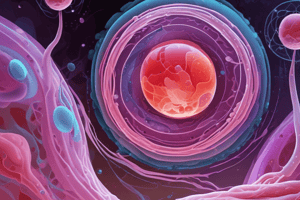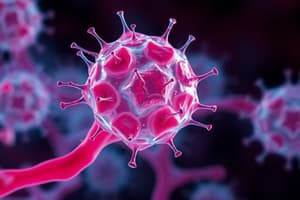Podcast
Questions and Answers
What is the definition of Lipoma?
What is the definition of Lipoma?
Benign tumour of fatty tissue.
Where does Chondroma originate?
Where does Chondroma originate?
- Ends of long bones
- Short bones like hands and feet
- Flat bones like sternum, pelvis, and scapula
- All of the above (correct)
Describe the microscopic picture of Fibroma.
Describe the microscopic picture of Fibroma.
Consists of interlacing bundles of fibroblasts having spindle-shaped nuclei with tapering ends.
Osteoma is a benign tumor of ________.
Osteoma is a benign tumor of ________.
Melanomas are benign melanocytic lesions.
Melanomas are benign melanocytic lesions.
Flashcards are hidden until you start studying
Study Notes
Mesenchymal Tumors
- Mesenchymal tumors originate from mesenchymal tissues (connective tissue, fat, bone, cartilage, smooth muscle, striated muscle, blood vessels, and peripheral nerves)
Benign Mesenchymal Tumors
Connective Tissue Tumors
- Lipoma: benign tumor of fatty tissue, rare malignant transformation
- Sites of origin: subcutaneous fatty tissue of the back, shoulder region, and buttocks
- Gross picture: capsulated, well-circumscribed, yellowish, and soft
- Microscopic picture: lobules of mature adult fat cells separated by delicate fibrovascular tissue septa within a capsule
- Fibroma: benign tumor arising from fibrous connective tissue
- Sites of origin: skin, subcutaneous tissue, fascia, and tendons
- Gross picture: capsulated, soft or hard
- Microscopic picture: interlacing bundles of fibroblasts having spindle-shaped nucleus with tapering ends
- Desmoid tumor: recurring fibroma arising from the muscular aponeurosis of the abdominal wall
- May be due to trauma and repeated pregnancy
- Locally infiltrative and recurs after surgical removal, but does not show evidence of malignancy
Cartilaginous Tumors
- Chondroma: benign tumor of hyaline cartilage
- Sites of origin: ends of long bones, short bones (enchondroma), flat bones (sternum, pelvis, and scapula), and extraskletal soft tissue chondroma and bronchial chondroma
- Gross picture: well-circumscribed, hard tumor mass, may be lobulated or rounded
- Microscopic picture: islets of cartilage separated by fibrous tissue septa, rare malignant transformation
Bony Tumors
- Osteoma: benign tumor of bone
- Types:
- Compact or ivory osteoma: affects the membranous bone as the skull
- Gross picture: smooth surface, hard mass
- Microscopic picture: concentrically compact bone lamellae
- Osteoid osteoma: very painful, affects adults, more common in males
- Sites of origin: the tumor arises in any bone, commonly in the cortex
- Gross picture: solitary, less than 1 cm, radiolucent small lesion (nidus) surrounded by dense sclerosing margins
- Microscopic picture: center of osteoid and poorly mineralized woven bone surrounded by dense calcified bone
- Cancellous osteoma (osteochondroma)
- Sites of origin: from the epiphyseal cartilage of a growing long bone
- Gross picture: uncapsulated mass projecting from bone and covered by epiphyseal cartilage
- Microscopic picture: formed of irregular bone trabeculae covered by cartilaginous cap
- Compact or ivory osteoma: affects the membranous bone as the skull
- Types:
Muscular Tumors
- Rhabdomyoma: very rare benign tumor of striated skeletal muscles and heart muscle
- Leiomyoma: common benign tumor of smooth muscle
- Sites of origin: uterus, GIT (stomach, esophagus, and intestine), and other areas where smooth muscles are present
- Microscopic picture: interlacing bundles of smooth muscle with fibrous stroma, the muscle fibers are running in various directions
Vascular Tumors
- Hemangioma: benign tumor of vascular endothelium
- Types:
- Capillary hemangioma
- Cavernous hemangioma
- Types:
- Lymphangioma: benign tumor or hamartoma composed of lymphatic vessels
Nervous Tumors
- Schwannoma: benign tumor of Schwann cells
- Neurofibroma: benign tumor of peripheral nerves
Malignant Mesenchymal Tumors (Sarcoma)
- Sarcoma: malignant tumor of connective (mesenchymal) tissues
- Characters of sarcoma:
- Less common than carcinoma
- Affects younger age group than carcinoma
- Size: bulky masses with areas of hemorrhage and necrosis
- Microscopic picture: very cellular, individual cells are arranged singly and separated by intercellular stroma
- Metastasis: occurs early by blood due to high vascularity, spreads commonly to the lung
- Classification of sarcoma: according to the tissue of origin
- Types of differentiated sarcoma:
- Fibrous tissue: fibrosarcoma
- Fatty tissue: liposarcoma
- Bone tissue: osteosarcoma
- Cartilage tissue: chondrosarcoma
- Smooth muscle: leiomyosarcoma
- Striated muscle: rhabdomyosarcoma
- Nerves: neurofibrosarcoma
- Blood vessels: angiosarcoma
- Types of differentiated sarcoma:
Locally Malignant Tumors
- Characteristics:
- Slow rate of growth than frank malignant tumors
- Local invasion and destruction by infiltration only without distant metastasis
- Microscopic features of malignancy
- Prognosis: may recur, especially after incomplete removal
- Examples:
- Basal cell carcinoma
- Giant cell tumor of bone (osteoclastoma)
- Adamantinoma of the mandible
- Some intracranial tumors (craniopharyngioma)
- Carcinoid tumor of the intestine
- Bronchial adenoma (carcinoid)
- Desmoid tumor or fibromatosis
Studying That Suits You
Use AI to generate personalized quizzes and flashcards to suit your learning preferences.




